#corymbiate
Text
Cute teen opens up yummy quim and gets deflorated
Twink with glasses cums hard while getting bareback fucked
African Girl Gets Huge Cum Facial!
Lady boy masturbations
Oily PAWG bounces on big fat dick
In blue high heels shoe play and next feet job with red dildo
Sexo oral / hotel tlalpan / Alizee S anzeth
Groped Granny Ass
Large tit white chick is having interracial sex with black guy
Dreamgirl (OPP video)
#reconfiguring#incloude#subsaturated#corymbiate#intensitive#phousdar#unhipped#hylopathy#vinously#watchbands#urochromogen#contemporised#putteringly#screwer#nontrier#flain#metatungstic#inadequation#Gestalt#albified
0 notes
Text
In tomorrow's Metamorphoses
Bacchus transforms a crew of sailors into dolphins for attempting to kidnap him
iamdudum flebam: lacrimas manus inpia nostras
ridet et inpellit properantibus aequora remis.
per tibi nunc ipsum (nec enim praesentior illo
est deus) adiuro, tam me tibi vera referre
quam veri maiora fide: stetit aequore puppis 660
haud aliter, quam si siccam navale teneret.
illi admirantes remorum in verbere perstant
velaque deducunt geminaque ope currere temptant:
inpediunt hederae remos nexuque recurvo
serpunt et gravidis distinguunt vela corymbis. 665
ipse racemiferis frontem circumdatus uvis
pampineis agitat velatam frondibus hastam;
quem circa tigres simulacraque inania lyncum
pictarumque iacent fera corpora pantherarum.
exsiluere viri, sive hoc insania fecit 670
sive timor, primusque Medon nigrescere toto
corpore et expresso spinae curvamine flecti
incipit. huic Lycabas “in quae miracula” dixit
“verteris?” et lati rictus et panda loquenti
naris erat, squamamque cutis durata trahebat. 675
at Libys obstantis dum vult obvertere remos,
in spatium resilire manus breve vidit et illas
iam non esse manus, iam pinnas posse vocari.
alter ad intortos cupiens dare bracchia funes
bracchia non habuit truncoque repandus in undas 680
corpore desiluit: falcata novissima cauda est,
qualia dividuae sinuantur cornua lunae.
undique dant saltus multaque adspergine rorant
emerguntque iterum redeuntque sub aequora rursus
inque chori ludunt speciem lascivaque iactant 685
corpora et acceptum patulis mare naribus efflant.
de modo viginti (tot enim ratis illa ferebat)
restabam solus:
"'I was long since in tears; but the godless crew mocked my tears and swept the seas with speeding oars. Now by the god himself I swear (for there is no god more surely near than he) that what I speak is truth, though far beyond belief. The ship stands still upon the waves, as if a dry-dock held her. The sailors in amaze redouble their striving at the oars and make all sail, hoping thus to speed their way by two fold power. But ivy twines and clings about the oars, creeps upward with many a back-flung, catching fold, and decks the sails with heavy, hanging clusters. The god himself, with his brow garlanded with clustering berries, waves a wand wreathed with ivy-leaves. Around him lie tigers, the forms (though empty all) of lynxes and of fierce spotted panthers. The men leap overboard, driven on by madness or by fear. And first Medon’s body begins to grow dark and his back to be bent in a well-marked curve. Lycabas starts to say to him: ‘Into what strange creature are you turning?’ But as he speaks his own jaws spread wide, his nose becomes hooked, and his skin becomes hard and covered with scales. But Libys, while he seeks to ply the sluggish oars, sees his hands suddenly shrunk in size to things that can no longer be called hands at all, but fins. Another, catching at a twisted rope with his arms, finds he has no arms and goes plunging backwards with limbless body into the sea: the end of his tail is curved like the horns of a half-moon. They leap about on every side, sending up showers of spray; they emerge from the water, only to return to the depths again; they sport like a troupe of dancers, tossing their bodies in wanton sport and drawing in and blowing out the water from their broad nostrils. Of but now twenty men—for the ship bore so many—I alone remained.'" (Transl. Miller 1915)

9 notes
·
View notes
Text
The surprising truth about counterfeit Dragon’s blood
The truth is you haven’t been buying Dracaena draco, and the surprise is; that’s a good thing.
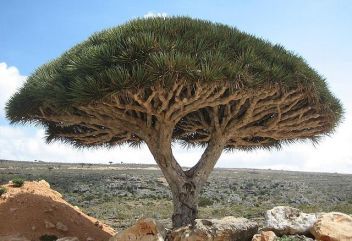
Dracaena cinnabari in it’s native habitat on the Socotra archipelago. Photo credit: Wikimedia commons.
Part one in a series on Dragon’s blood resin.
The other Dragon’s blood; latex, dye and poison
In a modern magical context, Dragon’s blood is often erroneously assumed to simply be the resin sap produced by the Dragon tree, but as with most things in this world, the truth is more nuanced.
The Calamus, Pterocarpus and Croton genera contain plants which produce gums, latexes and resins which have been labeled as Dragon’s blood; these have been used medicinally and as dyes. One example, the latex of the Sangre de drago , Croton lechleri, native to South America, can be used as a natural adhesive bandage.
As for their use as pigments, due to the nature of vegetable dyes, kino gums may resemble blood when oozing from wounds on a tree but often do not produce a red colour pigment.

The familiar kino of the Eucalyptus, Corymbis calophylla. Credit: Wikimedia Commons
Outside of ethnomedical studies and natural remedies, these forms of Dragon’s blood are of less prevalent concern to modern paganism.
Next up we have the brilliant but deadly vermilion, also known as Dragon’s blood, or China red. This was traditionally produced from powdered mineral cinnabar. Cinnabar is a highly toxic form of mercury sulphide which was used in antiquity as a dye, cosmetic and in jewelry. Unsurprisingly you’re not likely to encounter this stuff on the market in its natural form, although vintage Chinese cinnabar lacquered artifacts are attractive to collectors. While cinnabar is very dangerous, with careful handling the lacquer renders it relatively inert.

A wooden plate lacquered with cinnabar. Photo credit: Wikimedia commons
Finally, the form that most of us are more familiar with; Dragon’s blood incense. This is usually derived from either the Daemonorops or Dracaena genera; only the latter of which is also used as a dye.
The true Dragon’s blood tree
The Dragon’s blood resin you see for sale is very unlikely to be from the true dragon’s blood tree. It’s also worth noting that any form of genuine Dragon’s blood essential oil does not exist.
The popular houseplant known as Lucky bamboo, or Chinese water bamboo, Dracaena braunii, is actually a much closer relative to the genuine Dragon’s blood trees. Continuing the theme of misattribution, it is not Chinese nor a bamboo; it’s native to Cameroon in West Africa.
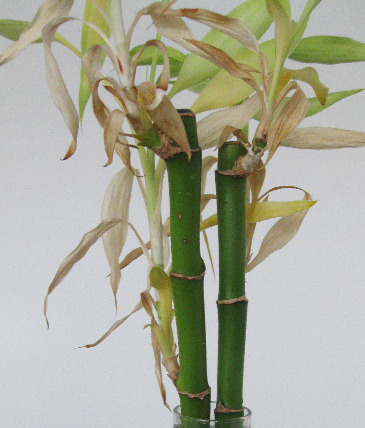
Some lucky bamboo growing on my altar.
The family it belongs to, Asparagaceae, gives us the Agave used in the production of tequila and, as one could guess from the name, the vegetable asparagus.
When people talk about the Dragon’s blood tree, they are usually referring to Dracaena draco or Dracaena cinnabari. Although there are other Dracaena species harvested for their resin, I’ll be focusing on these two as they’re the most widely known and referred to. Due to its distinctive long trunk with leafy branches extending from the crown, these trees are sometimes called a Dragon’s blood palm. This is unfortunate because it is not a palm, while its impostor is.
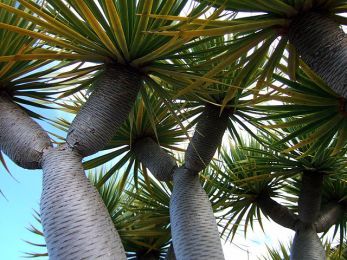
Not a palm. Photo credit: Wikimedia commons
Dracaena draco is a popular ornamental garden tree in Australia, whereas D. cinnabari is much less sought after due to its extremely slow growth rate and similar appearance. Given favorable conditions, the average Dragon’s blood tree takes 10 years to reach a height of just over one meter.
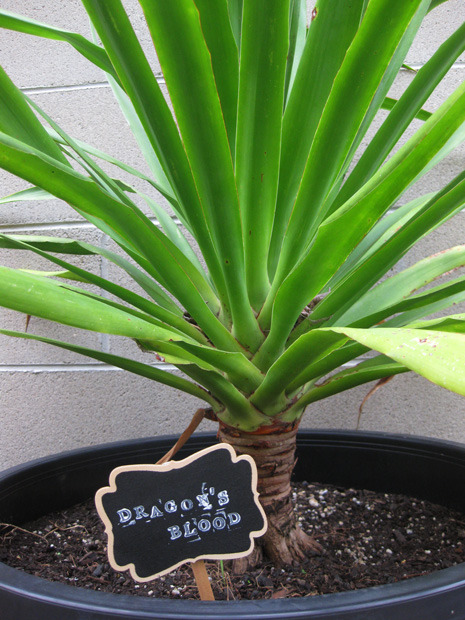
My child. I picked up this D. Draco at Bunnings when it was only 20cm tall. It’s now 3 years of age.
Unfortunately both D. Draco and D. Cinnabari are threatened species; vulnerable to extinction in their native habitats. Both trees have an incredibly slow growth cycle, taking over a decade to reach their first state of reproductive maturity. Habitat loss, over-harvesting, desertification, climate change and modern agriculture techniques all present hazards to their survival.
The common Dragon’s blood cane palm Daemonorops draco, sometimes referred to as Demon cane due to its thorns, is cultivated in Southeast Asia, with much of the resin on the market coming from Indonesia and Thailand. Endemic to the tropics close to the equator, the Arecaceaefamily of plants also gives us raffia and coconuts.
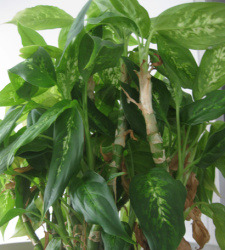
Not to be confused with the Araceaefamily like this Dieffenbachia dumb cane. Because whoever named them hated dyslexic people.
Daemonorops draco is the stuff you’ll commonly see for sale. I often see Dragon’s blood in stores labelled as Dracaena draco, but it’s increasingly rare and difficult to find genuine Dracaena resin.
Although it’s unfortunate that so many otherwise reputable outlets are mislabeling their product, the reasons I posited this as a good thing are threefold. Firstly, Dracaena draco resin, due to its rarity is prohibitively expensive.
Secondly is the issue of the commercial exploitation of an endangered species, making the use of a plentiful alternative attractive. Harvesting Dracaena resin leaves the tree vulnerable to fungal infection which may kill it. Due to this vulnerability and their low numbers, it is favorable that the commonly available Dragon’s blood incense is derived from the plentiful and fast growing Daemonorops draco, as demand for the resin could not be satisfied otherwise.
Thirdly is a matter of personal opinion in regards to their aromatic properties. The rare D. cinnabari and D. draco are almost entirely scentless unless actively being burnt. As Dragon’s blood resin is used in all sorts of aromatic products beyond incense, such as soaps and papers, these would lose their appeal if Dracaena was used in things that aren’t intended to be set on fire.
Conversely the subtle but commanding, warm, masculine scent of Daemonorops draco is quite pleasant and apparent even when not lit.

This red sigil chalk I made using palm Dragon’s blood should definitely not be set on fire.
Now that we’ve established the difference between these three types of Dragon’s blood resin, what about their aromas, magical uses and the mysterious Dragon’s blood ink?
In my next posts I will demonstrate the recipe for Dragon’s blood ink and explore the properties of Daemonorops draco, Dracaena draco and Dracaena cinnabari in greater detail.
1 note
·
View note
Photo

https://wordsthatrhymewith.com/corymbiate/
Words that rhyme with corymbiate | Words rhyming with corymbiate
0 notes